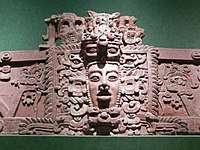Maya rulers
Maya kings were the centers of power for the Maya civilization. Each Maya city-state was controlled by a dynasty of kings. The position of king was usually inherited by the oldest son.
 |
| Maya civilization |
|---|
| History |
| Preclassic Maya |
| Classic Maya collapse |
| Spanish conquest of the Maya |
Symbols of power
Maya kings felt the need to legitimize their claim to power. One of the ways to do this was to build a temple or pyramid. Tikal Temple I is a good example. This temple was built during the reign of Yikʼin Chan Kʼawiil. Another king named Kʼinich Janaabʼ Pakal would later carry out this same show of power when building the Temple of Inscriptions at Palenque. The Temple of Inscriptions still towers today amid the ruins of Palenque, as the supreme symbol of influence and power in Palenque.
Succession
Maya kings cultivated godlike personas. When a ruler died and left no heir to the throne, the result was usually war and bloodshed. King Pacal's precursor, Pacal I, died upon the battlefield. However, instead of the kingdom erupting into chaos, the city of Palenque, a Maya capital city in southern Mexico, invited in a young prince from a different city-state. The prince was only twelve years old.
Expansion
Pacal and his predecessors not only built elaborate temples and pyramids. They expanded their city-state into a thriving empire. Under Yikʼin Chan Kʼawiil, Tikal conquered Calakmul and the other cities around Tikal, forming what could be referred to as a super city-state. Pacal achieved in creating a major center for power and development.
Responsibilities
A Mayan king was expected to be an excellent military leader. He would often carry out raids against rival city-states. The Mayan kings also offered his own blood to the gods. The rulers were also expected to have a good mind to solve problems that the city might be facing, including war and food crises.
Mayan kings were expected to ensure the gods received the prayers, praise and attention they deserved and to reinforce their divine lineage.[1] They did this by displaying public rituals such as processions through the streets of their cities. A more private ritual was that of blood sacrifice, which was done by Lords and their wives.[2]
See also
- List of rulers of Copan
- List of the rulers of Dos Pilas
- Rulers of Tikal
- Yaxchilan rulers
- Maya stelae
Further reading
- Lucero, Lisa Joyce (2006). Water and Ritual: The Rise and Fall of Classic Maya Rulers. Austin, TX: University of Texas Press. ISBN 0292709994. OCLC 61731425.
- Tiesler, Vera and Andrea Cucina (2006). Janaabʼ Pakal of Palenque: Reconstructing the Life and Death of a Maya Ruler. Tucson, AZ: University of Arizona Press. ISBN 0-8165-2510-2. OCLC 62593473.
References
- L., Tignor, Robert. Worlds together, worlds apart: a history of the world from the beginnings of humankind to the present (Fourth ed.). New York. ISBN 9780393123760. OCLC 854609153.
- Tignor, Adelman, Brown, Elman, Liu, Pittman, Shaw, Robert, Jeremy, Peter, Benjamin, Xinru, Holly, Brent (2014). Worlds Together, Worlds Apart (V1). New York, NY: W.W. Norton & Company, Inc. pp. 311–313. ISBN 9780393922080.CS1 maint: multiple names: authors list (link)